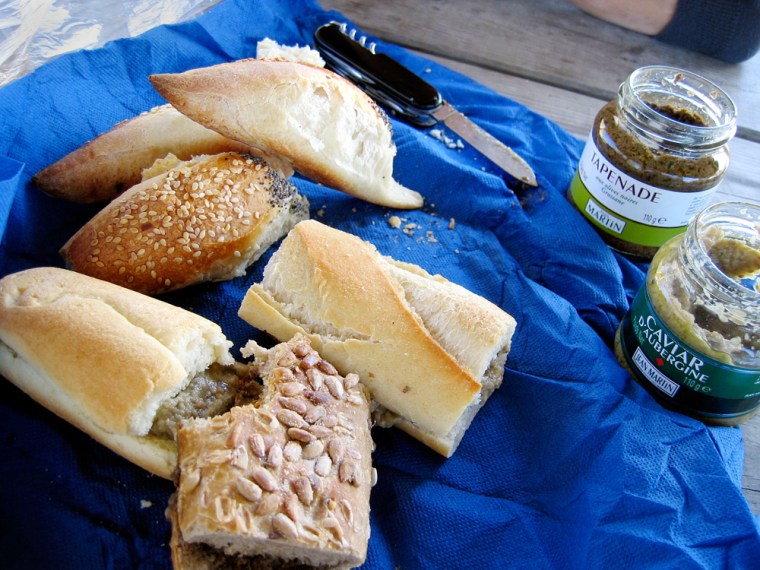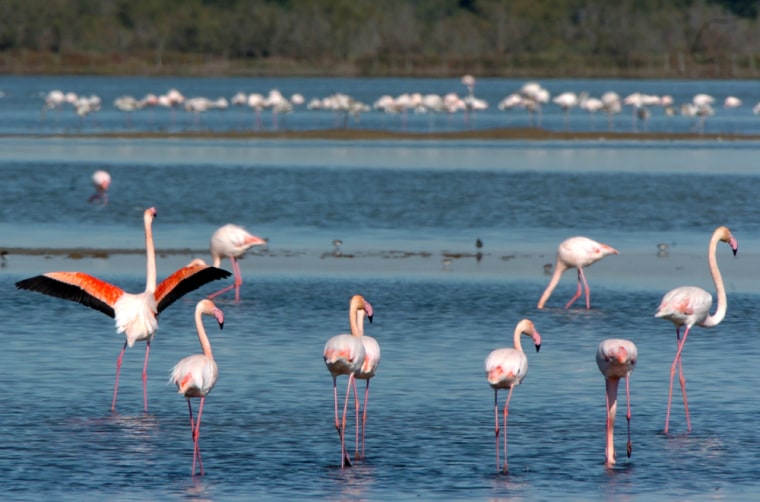In the weeks leading up to our first trip to Provence, we pored over guidebooks, reacquainting ourselves with images immortalized by Cezanne and popularized by the films "Jean de Florette" and "Manon Of TheSpring."
We fully expected to see fields of lavender, Roman ruins and old men playing petanque, and to feast on hearty stews redolent of garlic, tomatoes and thyme.
No one told us about the pink flamingos.
Much to our surprise -and delight - we encountered thousands of them, wading, feeding and flying in formation over the shallow lagoons of the Park of the Camargue, a half hour's drive south of Arles.
The Camargue, a wind-swept river delta bordering the Mediterranean Sea, is one of Europe's most important wetland sites, a nesting ground for pink flamingos and home to hundreds of other species of birds and other wildlife.
The park -an intricate patchwork of salt fields, rice farms, ranches and swamps -is protected by the French government, which has built a network of information centers, nature trails and observatories through the marshes and lagoons.
From the vantage point of comfortable blinds, we peered for hours at flocks of water fowl, marveling at the ability of the flamingos to retract one long, spindly leg beneath their bellies and balance on the other.
No matter how many of the exquisite creatures we saw, we only wanted to see more! You might say they blew a serious hole in our Provence itinerary.
When we were still planning our trip from home, we had planned on staying five nights in Arles, hoping to use it as a base to explore other towns and villages in the southern part of Provence.
A medium-size city rich in Roman ruins and history, Arles has no shortage of its own attractions: excellent museums, a vibrant outdoor market on Saturdays, an international photography festival in the summer.
We stayed at a charming bed and breakfast in the heart of the old city, which seems to be reinventing itself with the arrival of energetic young people like the proprietors of our B&B.
Some of the ancient houses along the narrow, winding streets have been renovated and painted in delicate pastel hues. Just down the street from our lodging was an organic bakery, and not far from there, a shop selling locally produced olive oil.
We made a pilgrimage to a cafe terrace on the Place du Forum featured in a famous painting by Vincent Van Gogh, who lived in Arles for one short, extraordinarily productive year of his troubled life.
We inspected giant vats of paella and tables brimming with local cheeses at the farmers market on Saturday -but mostly we hung out in the Camargue.
The trip from Arles was easy: Cross over the Rhone and take the D36 south. At a certain point, the two-lane highway splits off onto a narrower road that leads past a visitor information center at La Capeliere.
There, and farther down the road at Salin de Badon, visitors can meander along well-groomed nature trails and observe egrets, herons, ducks and other water fowl from viewing platforms built over tall seas of reeds and other wild grasses.
Having come this far to the southeast corner of Provence, we decided it was crazy to leave the region without at least putting our feet in the Mediterranean, even though when were there, it was November.
So we drove to a parking area at the southeast edge of the park's largest lagoon, the Etang du Vaccares, and hiked toward the Phare de la Gacholle. Just before the entrance to the lighthouse, we veered left and marched across the dunes to the sea.
Despite the intense heat of the midday sun, the air was cool. A stiff wind from the north ruffled the surface of the salt marshes. Off in the distance, kite-surfers danced over the sparkling green waves.
After reaching the water's edge, we retreated to the dunes, where we picnicked on our provisions from Arles -bread, cheese and sausage. As we huddled against the wind, fearful that the wind would carry off an unattended napkin or paper bag, several people galloped past on horseback.
With the sun now arcing toward the west, it was time to pack up our belongings and head back across the dunes.
Freshly whitewashed and sporting bright blue shutters, the lighthouse also served as a visitor information center for this section of the park. Inside, there were simple displays of shells, feathers and wildflowers to illustrate the ecology of the nature preserve.
Like the other tourist facilities in the park, it was decidedly low-tech, reminiscent of a 1950s-era science classroom. A few books, posters, t-shirts and post cards were for sale, but nothing approaching the commercial scale of a typical gift shop in the U.S. park system.
If there was a slightly worn look to the nature preserve, it might be because human beings have been fussing here for centuries. Salt production alone dates back to the time of the Romans.

The seaside resort of Saintes-Maries-de-la-Mer, where some believe Mary Magdalene and other early Christians washed ashore in a boat from Jerusalem in 40 A.D., has attracted religious pilgrims for nearly two millennia.
Besides its human inhabitants, the Camargue has long supported wild herds of black bulls and white horses, which have given rise to a French-style cowboy culture. French President Nicolas Sarkozy was photographed there on a white horse two days before the first round of the elections in France earlier this year.
Tourists can watch bullfights; explore the Camargue on horseback alongside the gardians, or French cowboys; and sample the distinctive flavors of bull meat and sausage in local shops and restaurants.
Whether you're a wannabe cowhand, a devoted birdwatcher or a devotee of Van Gogh, you're likely to find something in the park that strikes a chord.
I, for one, will never forget the flamingos we saw, which, by the way, are not Pepto-Bismol pink.
Their plumage comes in delicate hues of rosy pink and white, with dramatic black flight feathers visible when their wings are extended.
The lawn ornament manufacturers who have turned these spectacular-looking birds into tropical kitsch have simply got it wrong.
